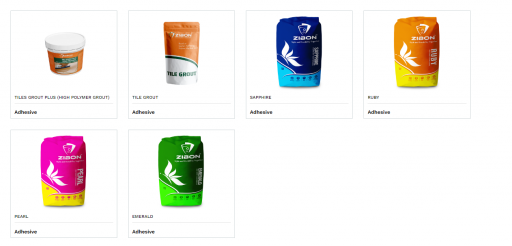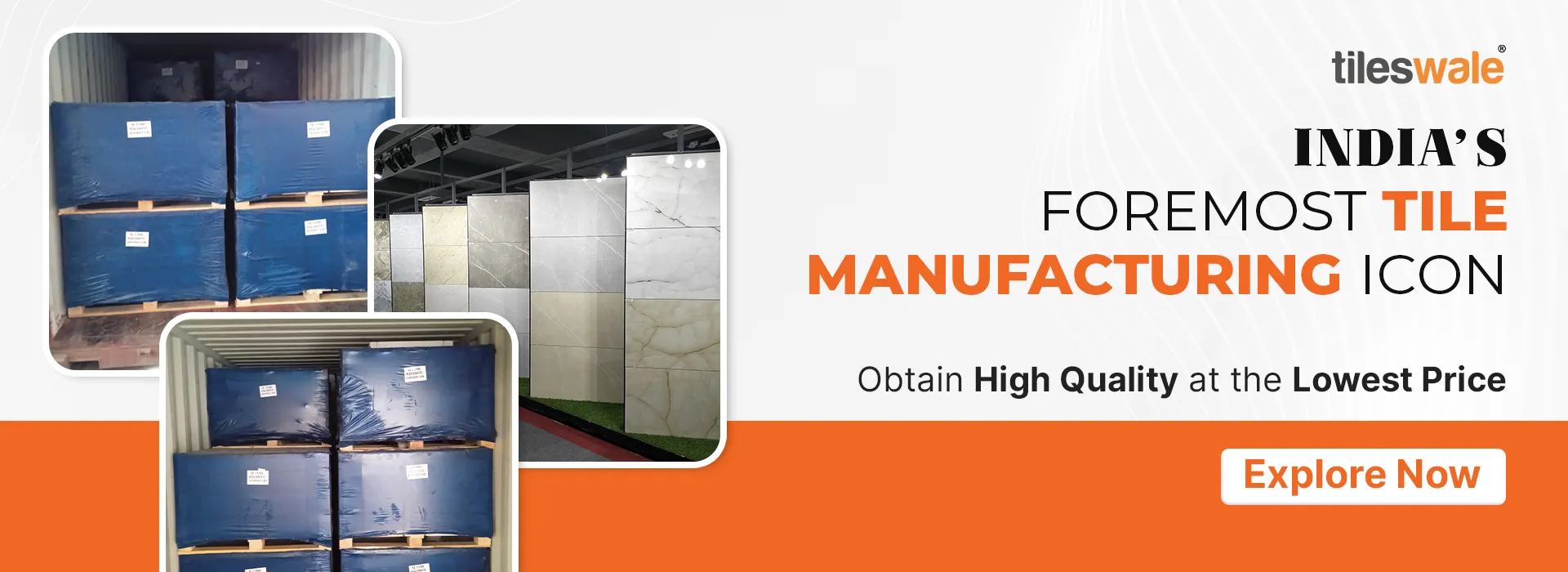
World's First Ceramic-Tile & Sanitaryware Live Marketplace. Get it on Google Play
Get it on App Store
World's First Ceramic-Tile & Sanitaryware Live Marketplace. Get it on Google Play
Get it on App Store
By Tileswale
The word “adhesion” comes from the Latin word “adhaerere.” It means “to stick to” something. Humans have used different types of adhesives for different reasons for centuries. Adhesives were first described in a scientific context by physicist Robert Boyle in 1661. Since then, adhesives have been studied and improved by various scientists.
In the construction world, one adhesive has dominated the playing field for centuries – cement. For tile installations, construction companies would use a mixture of cement, sand, and water. However, cement is only efficient at holding bricks together. It’s not good at holding tiles together.
Tiles installed with cement-based adhesives become loose and come out far too quickly. Still, it was the only tile adhesive construction companies used for centuries. Thankfully, construction techniques have evolved a lot in the past three decades and so have tile adhesive chemicals.

New-age tile adhesives come ready-mixed. They’re specially formulated from high-quality cement, fine sand, and different types of additives and chemicals. These ingredients give tiles adhesive glue the essential properties needed for laying tiles. These high-performance adhesives can be used to install tiles on all types of substrates.
Horizontal or vertical masonry surfaces, wooden substrates, existing tiles, polished cement, interior/exterior wall surfaces, swimming pools, and more. These adhesives stick suitably for long periods to all types of base surfaces. They hold tiles in their respective positions for long durations without de-bonding issues.
Let’s learn everything about this high-performance, new-age tiles adhesive.
The practice of laying tiles with glue became popular because cement mortar, the traditional adhesive for paving tiles, was ineffective. Why? Well, cement mortar consists of many materials. Silica, limestone, shells, and various other ingredients are ground into a fine powder to produce cement. This cement is then added to sand to produce the bonding agent cement called mortar.
The ingredients in this bonding agent can be activated by water. So, tile installers mix cement mortar with water to start the tile-laying process. They cover the base surface with wet cement mortar. When the water evaporates, cement mortar dries to form solid adhesive bonds between the tiles and the base surface.
This process is called “cement hydration.” It’s effective, but the adhesive bonds aren’t flexible or crack-resistant. Floor tiles experience a lot of traffic. So, tiles laid with cement mortar become loose and wobbly very quickly. That’s when people need tile fixing adhesive. New-age tile adhesives have similar ingredients to cement mortar.
But, they also come with additional polymers. These polymers are specially formulated to give the tile adhesives added flexibility and crack resistance. The polymers are added in specific proportions to the adhesives. So, the two basic differences between old-school cement mortar and a new tile adhesive ready mixed product are –
Different ingredients. The extra polymers in new-age tile adhesives make them stronger bonding agents.
Since the ingredients are different, the features/properties of the two also differ widely. Tile adhesives offer more – compressive strength, open time, sag resistance, tensile adhesion strength, correction time, and split-tensile strength.
Here are some reasons why new-age tiles glue has replaced traditional cement mortar:
Traditional cement mortar has to be purchased in huge quantities. Tile adhesives are available in very small packages. They’re more practical for small jobs like re-attaching one loose tile on the floor.
To lay tiles with traditional cement mortar, you’ll have to soak the tiles for at least one day. Only then will the sand-cement mortar attach tightly with the tiles. Tile adhesives can be prepared and applied at any time and almost anywhere. There’s no need to prepare the tiles.
To lay tiles with traditional cement mortar, you’ll have to apply the mixture on each tile’s back. This “one tile at a time” approach is very time-consuming.
Traditional cement mortar offers very poor bonding strength on certain types of surfaces. You can’t use this adhesive to lay tiles on substrates that are subject to high-pressure impacts. You can’t even use this sand-cement mixture on existing tiles.
These are the reasons why new-age tile adhesives are taking over. Different varieties of these adhesive agents are available in the market. Want to lay tiles on your bedroom walls? You can find chemical-free tile adhesives that are designed for safe, indoor use.
Need new tiles for the community swimming pool? Again, you can get tile adhesive exterior products that are formulated to resist harsh outdoor conditions. But, how will you use these adhesives to lay tiles? How do they work? Let’s explore.

When you buy tiles glue you’ll probably receive a packet full of powder. Most tile adhesives come in powder forms. This powder is a premixed blend of specially selected cement, well-graded fine sand, latex, and other polymers. You’ll have to mix this powder with water to create your tile adhesive. Don’t worry, these bonding agents don’t need extensive water curing.
Different types of tile adhesives are made for different types of surface applications. Select a product that’s designed to work in your specific usage areas and atmosphere. Here’s how the adhesives will work from then on –
Create your adhesive paste and apply it to the surface (preferably with a notched trowel).
Spread the paste across the surface uniformly. Within seconds of application, the adhesive will start creating strong bonds with the surface.
Lay the tiles. Avoid using the newly tiled surface for 24 hours. After that, your new tiles will be ready to use.
Laying tile with adhesive is easy because these adhesives have astounding adhesion properties. They ensure that the tiles don’t slip, shrink, chip, or break by keeping their bonds with the base surfaces super-tight. Tile-fixing adhesives work perfectly well with ceramic tiles and natural stone tiles. A simple ceramic tile adhesive can be used to install tiles on various substrates including –
Glass mosaics
On polished substrates
On existing tiles
On substrates that experience heavy movement
On substrates that experience high-pressure impacts
On substrates that experience thermal sock
Using tile adhesive ready mixed became popular because laying tiles with cement mortar was too tedious and expensive. No one wants to soak their tiles for 24 hours before the installation. No one wants to make slurry cement mortar mixes either. There’s also the risk of adding too much water to the mixture and creating a messy, unusable adhesive.
With ready-mixed tile adhesives, there are no such risks. They’re specially formulated with high-quality cement, fine sand particles, and chemical additives. They come in packs that clearly mention how much water users need to add to get the best results.
Plus, users can lay tiles with these high-performance tile adhesives virtually on any surface/substrate, including on existing tiles. Here are some other advantages of these new-age tile adhesives –
Ease of Use: Even a layman can tile with adhesive. These “ready-to-use” adhesives come in small powder bags. Users simply need to mix the powder with water (adequate amounts depending on the surface area) to start the tile-laying process. The process isn’t messy at all.
Fast Application: Users can continuously lay one tile after another when using new-age tile adhesives. Adjust each tile into the lines, use a notched trowel to apply the adhesive, and progress to the next tile.
High-Quality Results: Both tile adhesive exterior and interior offer very flexible setting times. Users get enough time to adjust and place their tiles when working with these adhesives. Applying the adhesive with a notched trowel is also a super-easy process. With notched trowels, users can fully spread the adhesive on the back of their tiles. Once installed, the tiles don’t shake, break, stain, or allow water to seep in. Overall, laying tiles in aesthetic and functional styles is much easier with tiles adhesive. Plus, the strong bonding strength of the adhesives ensures that the tiles stay in their positions for long periods.
Cost and Time-Effective: To lay tiles with glue, you’ll require way less time, effort, and fewer raw materials. One 20 kg bag of ceramic tile adhesive will offer a coverage area of 4 to 6 m2. Plus, tilers can lay the tiles one after the other without wasting any time or raw materials. Once installed, the water-resistant adhesives keep the tiles bound to their surfaces for several years.
These economic reasons make tile adhesive waterproof a highly attractive product for construction companies and individual property owners. Buying tile adhesives that are specially formulated to suit your application makes total sense.
From parking areas to industrial factories to swimming pools to homes – you can find specific tile adhesives for different applications. Here’s a recap of the main advantages of new-age tile adhesive:
Faster
Water-resistant
Easier to use
Offers stronger bonding strength
Applicable on all types of substrates
Despite these advantages, tiles adhesive glue isn’t a perfect product.
The shelf life on most tile fixing adhesive products is typically 12 to 24 months. Ready-mixed and powder adhesives tend to lose their strength after this period for various reasons. Whether you open your tiles gum bag or not, it will begin to set after the 12-month mark. Powder adhesives may begin to set due to moisture getting inside the package.
Ready-mixed adhesives may lose their quality if small amounts of air get inside them. That’s why shoppers must always avoid buying tile adhesive chemicals that are over a year old. Upon purchase, make sure there are no hard lumps in the packet containing the adhesive. Expired adhesives contain these lumps.
They harden too quickly when mixed with water. Some may not harden at all due to the expiration of the setting agent inside the mixture. So, never use an adhesive that’s due to expire soon. Only buy freshly manufactured tile adhesive - ready mixed or powder.
Currently, there’s a huge demand for commercial adhesives solutions. Addressing this demand is a whole host of companies that sell modern tile adhesives. Naturally, choosing the right tile adhesive that specifically meets your requirements isn’t easy. Don’t worry – when shopping for tiles adhesive, consider the following factors to ensure you’re buying the right product –
Buy the Right Type: Do you need ready-made, premixed adhesive solutions or tile adhesives that come in powder form? Do you need tile adhesive waterproof? Are you using your tile adhesive for exterior or interior tile-laying processes? Make sure the type of adhesive you purchase exactly suits your application requirements. For instance, tile gum is suitable for laying small indoor ceramic tiles. For laying bigger-sized tiles, you’ll need tile adhesive chemicals that produce stronger bonds.
Application Surface: What’s the nature of the surface over which you’re planning to install new tiles? Different types of tile adhesives suit different types of surfaces. For instance, tile adhesive waterproof is ideal for laying tiles near swimming pools. Premixed tile adhesive paste is better for installing smaller tiles indoors. Always check the types of surfaces the adhesives you plan to buy stick to.
Wall or Floor: Both floor and wall tile adhesives need to offer super-strong bonding. But, they need to have some specific special properties as well. For instance, floor tiles require flexible adhesion. Floor traffic will cause floor tile adhesives to experience severe wear and tear. The adhesive you purchase for your floor tiles needs to be designed to tackle such challenges. On the other hand, wall tiles don’t have gravity on their side. So, low-grip adhesives don’t work with wall tiles.
Setting Time: How quickly do you need to use your tiles once they are laid? Different types of tiles glue offer different setting times. Readymade, premixed adhesives set quicker than their powdered counterparts. So, if you’re in a rush, opting for readymade, premixed adhesives make sense.
Brand: Only buy freshly manufactured tile adhesives from reputed brands, especially if you’re shopping online. Top tile adhesive companies tend to offer reliable and long-lasting products. These companies also have easily accessible customer service teams. In case your tile fixing adhesive doesn’t work, you can at least call them up for replacements. That’s why Tileswale, the biggest network of construction material sellers in India only hosts certified sellers who offer these qualities. Shoppers can feel assured for years (if not decades) when they buy their tile gum from reliable manufacturers or suppliers. They’ll also pay fair prices.
Color: Yes, you can buy adhesives that perfectly complement the color of your tiles. Smart shoppers pick deeper adhesive and tile colors as they don’t pick up visible stains. Light-colored adhesives look perfect with light-colored tiles. Consider these aesthetic details before buying tiles adhesives.
According to Indian tile adhesive standards (IS 15477 - 2004), there are five types of adhesives. They’re specified as - Type 1, 2, 3, 4, and Type 5. They’re classified on the basis of their ability to lay tiles of different porosity. Here’s a brief look into the characteristics of these five types of adhesives –
Type 1 Adhesive: Made for tiles with 3% or more porosity. Type 1 tiles adhesive is ideal for laying ceramic tiles and porous natural stone tiles.
Type 2 Adhesive: Made for tiles with less than 3% porosity. They include - glass mosaic tiles, fully vitrified tiles, and stone tiles.
Type 3 Adhesive: Designed for laying tiles on exterior surfaces (e.g., on wall substrates made of plaster or concrete).
Type 4 Adhesive: Installing tiles on dry wallboard substrates like plywood, wood, medium density fiberboards, or cement boards? Then Type 1, Type 2, and Type 3 adhesives won’t do the job. For dry wallboard substrates, you’ll need Type 4 tile adhesives.
Type 5 Adhesive: Type 5 Adhesives are mainly used for special tile installation purposes. For instance, if you’re installing heavy tiles made of engineered stone on glass/metallic substrates, you’ll need a Type 5 adhesive.
In addition to these technical standards, there are other ways to distinguish tile adhesives. For example, ceramic tile adhesive will work specifically on ceramic tiles. Or, tile adhesive waterproof is useful for installing swimming pool tiles where reducing slip-and-fall risks is the priority.

Different types of tiles adhesive are used for different applications. The main applications of these products are:
Tiles Adhesive for Tile Flooring: Typically, people use cement-based tile adhesives that are “polymer-modified” to lay floor tiles. They offer extra strength and waterproof properties so they can be used for laying bathroom or kitchen floor tiles. Acrylic makes floor tile adhesives moisture-resistant. Latex makes these adhesives more flexible.
Tiles Adhesive for Wall Cladding: Again, polymer-modified tile adhesives are used to install tiles on wall claddings. These adhesives have extra non-skid properties. Both vitrified and non-vitrified tiles can be laid with wall cladding tile adhesives.
Tiles Adhesive for Glass and Mosaic: Tiles on glass and mosaics need to be bonded very strongly. Or else, they may become loose or crack the glass or mosaics underneath. So, special extra-strong adhesives are used for these applications. These adhesives also need to be white in color. So, they’re generally the most expensive type of adhesives in the market.
Fixing New Tiles on Old Flooring: Want to fix new tiles on your existing tile flooring? You’ll need a tile adhesive that contains special polymers. These polymers should make your adhesive averse to shrinking or slipping. No shrinking or slipping means that your new tiles will remain stuck to the older tiles underneath for long periods.
Tiles Adhesive for Fixing New Tiles on Wood: Yes, you can buy special tile adhesives that are specially manufactured to fix tiles on wooden subfloors. These polymer-modified adhesives have special additives that increase their high bonding strength. Wooden surfaces are typically very vibration-prone. The vibrations don’t damage the bonding strength of these adhesives.

You can buy tiles adhesive glue in 500-gram packs or 50kg bags. You can even find tile gum with special properties like no shrinkage or rapid setting in packs of different sizes. How much tile adhesive will you need?
A 20kg bag of tile adhesive chemical will cover up to 5 m2 of tiles (bed thickness of 3mm maximum). Use this metric to determine how much tile adhesive (powder) you’ll need. Always buy 10% extra to account for spillages or mishaps during the tile-laying process.
A simple 500gram tile adhesive pack (powder) will cost you anywhere between ₹150 to ₹300. Larger, 20 kg packs of multipurpose tile adhesives can cost up to ₹1600. Want the best deals? Shop online. Compare the prices/features of different tile adhesives. Only buy the one that’s fairly priced, from a reputable brand, and suited for your application.

If you’re shopping online, TilesWale, the B2B2C platform is the perfect place. This online marketplace for tiles, sanitaryware, floorings, adhesives and other related products hosts the best tile adhesive sellers in India. Buyers can directly check out the product catalogs of the world’s top tile adhesive sellers on TilesWale.
You can compare prices, check product details (e.g. expiration date), and buy exactly the tile adhesives you need. Since TilesWale has over 200k registered users and 35,000+ verified suppliers, shopping on the platform is very safe.
Shoppers only get access to verified products from the best adhesive manufacturing companies in India. Some of these companies include – Roff, Pidilite, Mapei, Dr. Fixit, Fosroc India, BASF, Tigonis, and other international and local brands.

If you buy tile adhesive ready mixed, you won’t have to mix it with water. But, if you buy powder adhesive, you’ll have to mix it with water first. Before you do that, prepare your surfaces for tiling. Then, take these steps:
Follow the manufacturer’s instructions (on your tile adhesive’s packaging) to learn how much water you need to mix. Pour the stipulated amount of water into your bucket containing the powder. Wear protective clothing (gloves, eyewear, etc.) during this process.
Stir the watery adhesive. Use a mixing paddle to stir the mixture until there are no lumps or dry powder particles inside the bucket.
Start applying the adhesive to your walls, floors, or other areas. Start with a small area. Don’t apply too much of your mixture to one tile area. Use a notched trowel to simplify this process.
Create channels with your notched trowel. Push each tile into the adhesive gently. Secure them to ensure there are no air particles between the base surface and the tiles.
Keep repeating this process. Use spaces to separate each tile along the way. Once every tile is installed allow the tile gum to set. Check the instructions regarding drying time on the packaging.
Once you’ve mixed and applied your tiles adhesive glue, it’s time for grouting.
The market is currently full of different types of adhesives. Buying tile adhesive with the right mix ratio and high-quality ingredients is very important. Tile adhesives are critical components in modern-day floors, walls, and other surfaces. Use this guide to find the right adhesives and complete your tile-laying project successfully.
You’ll need a notched trowel to spread the tile adhesive onto your floor or wall.
Tile adhesives are called “modified cement” because they contain different types of chemical additives. Typically, these glues contain polymers that give them better tensile and shear strengths.
Technically no tile adhesive is 100% waterproof. But, you can buy thin-set tile adhesives that are highly water-resistant. They’re not affected much by moisture.
For floor tiling (on concrete and timber surfaces) you’ll need to apply 2.5mm to 3mm thick adhesives. For wall tiling, the thickness should be anywhere between 1mm and 2mm.
Anywhere between 2 to 48 hours depending on conditions, product quality, etc.
No. Tile adhesives contain cement, sand, and special polymers.
Yes.
Adhesive.
Maintain a ratio of 1-part water and 2.5 parts powder (by volume) while mixing the tile adhesive. Mix until you obtain a smooth uniform consistency. Use within 3-5 hours of mixing.
You weaken their bonding strength. The more you make the mixture thinner by adding water, the more water molecules there are in the mixture. Water-heavy adhesives create bonds that crumble, crack, and prematurely deteriorate very quickly.
Article Updated - June 08, 2022
Submit your inquiries, we will see the rest
size:
Quantity:

+ Requirements

We have received your Inquiry. We will soon connect you with relevent Sellers via tileswale App. download now!!

